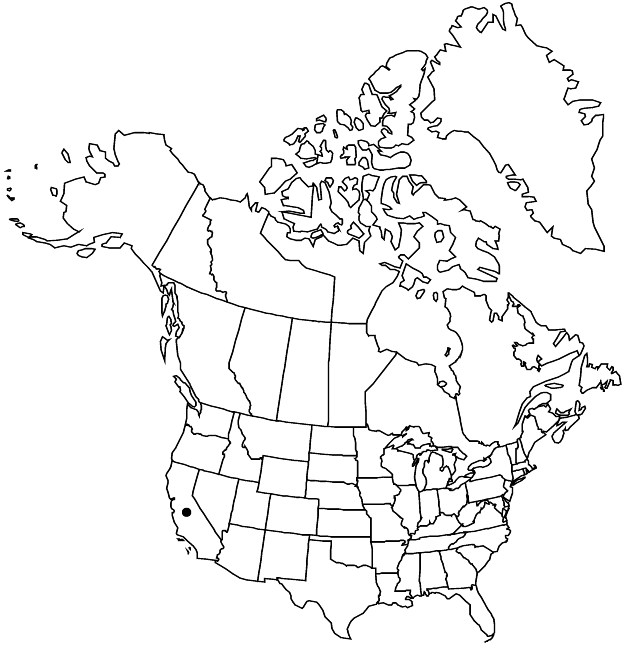Difference between revisions of "Chorizanthe obovata"
Ann. Missouri Bot. Gard. 21: 70. 1934.
FNA>Volume Importer |
imported>Volume Importer |
||
| (4 intermediate revisions by one other user not shown) | |||
| Line 8: | Line 8: | ||
}} | }} | ||
|common_names=Spoon-sepal spineflower | |common_names=Spoon-sepal spineflower | ||
| + | |special_status={{Treatment/ID/Special_status | ||
| + | |code=E | ||
| + | |label=Endemic | ||
| + | }} | ||
|basionyms= | |basionyms= | ||
|synonyms= | |synonyms= | ||
| Line 33: | Line 37: | ||
-->{{#Taxon: | -->{{#Taxon: | ||
name=Chorizanthe obovata | name=Chorizanthe obovata | ||
| − | |||
|authority=Goodman | |authority=Goodman | ||
|rank=species | |rank=species | ||
| Line 47: | Line 50: | ||
|publication title=Ann. Missouri Bot. Gard. | |publication title=Ann. Missouri Bot. Gard. | ||
|publication year=1934 | |publication year=1934 | ||
| − | |special status= | + | |special status=Endemic |
| − | |source xml=https:// | + | |source xml=https://bitbucket.org/aafc-mbb/fna-data-curation/src/2e0870ddd59836b60bcf96646a41e87ea5a5943a/coarse_grained_fna_xml/V5/V5_957.xml |
|subfamily=Polygonaceae subfam. Eriogonoideae | |subfamily=Polygonaceae subfam. Eriogonoideae | ||
|genus=Chorizanthe | |genus=Chorizanthe | ||
Latest revision as of 22:15, 5 November 2020
Plants erect to prostrate, (0.5–)1–3(–4) × 1–4(–5) dm, pubescent. Leaves basal; petiole 0.5–2(–3) cm; blade oblanceolate, 0.5–2.5 × 0.3–1 cm, thinly pubescent adaxially, soft-hirsute abaxially. Inflorescences with involucres in open clusters 2–4(–6) cm diam., greenish or reddish; bracts 2–3 at proximal node, usually leaflike, without whorl of sessile bracts about midstem, elliptic, 0.5–1.5 cm × 2–6(–8) mm, abruptly reduced above proximal node, becoming scalelike, linear, aciculate, acerose, 0.2–1 cm × 1–3 mm, awns straight, 1–2 mm. Involucres 3–10+, grayish, urceolate, slightly ventricose basally, 3–4 mm, slightly corrugate, without scarious or membranous margins, thinly to densely pubescent; teeth erect to spreading, unequal, 1–2 mm; awns straight or uncinate with longer anterior one straight, mostly 1 mm, others uncinate, 0.5–1 mm. Flowers exserted; perianth bicolored with floral tube greenish white to white and tepals white to pink, cylindric, 4–4.5(–5) mm, sparsely pubescent; tepals connate 1/2 their length, dimorphic, obovate, those of outer whorl spreading, 2 times longer than those of inner whorl, rounded or slightly obcordate apically, those of inner whorl erect, narrower, fimbriate apically; stamens (6–)9, mostly included; filaments distinct, 4–4.5 mm, glabrous; anthers yellow to golden, oblong, 0.9–1.1 mm. Achenes brown, globose-lenticular, 3–3.5 mm. 2n = 38, 40, 42.
Phenology: Flowering May–Jul.
Habitat: Sandy or calcareous soils, mixed grassland, coastal scrub, or chaparral communities, pine-oak woodlands
Elevation: 10-1300 m
Discussion
Chorizanthe obovata is found in the Coast Ranges. The whitish flowers quickly distinguish it from C. palmeri and the other reddish-flowered members of this complex. Immature plants can be confused with C. staticoides; the floral features readily separate the two species.
Selected References
None.
